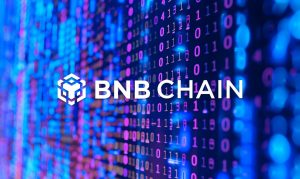In 2023, let’s unpack the dissimilarities between on-chain volume and trading volume
The concept of “on-chain volume” vs. “trading volume” is one that many cryptocurrency traders struggle to understand. On the surface, these two concepts seem very similar – both types of volume measure how much trading activity is taking place in a particular cryptocurrency. However, there are important differences between the two that can have a significant impact on how traders make investment decisions.

On-chain volume includes all the transactions happening on that particular blockchain, created from wallets and addresses directly linked to exchanges or other users. As such, it represents an accurate gauge of overall transactional activity for a specific digital asset.
Meanwhile, trading volume measures the amount of a given asset that has been bought or sold via an exchange – it is considered to be a key metric for gauging the popularity and liquidity of any digital asset on the market. Trading volume is also used by traders and investors alike to gauge market sentiment since higher trading volumes can often signify larger capital inflows into a specific cryptocurrency.
The differences between on-chain volume and trading volume are an important consideration for any investor looking to invest in a digital asset. While both metrics can give insight into the overall activity surrounding an asset, trading volume is generally considered more effective at tracking market sentiment. On-chain volume can provide a clearer picture of actual transactional activity, but it can also be easily manipulated by exchanges or whales.
Ultimately, the best way to gauge an asset’s performance is to keep track of both on-chain volume and trading volume to get a comprehensive overview of its standing in the market. By understanding the dissimilarities between these two metrics, investors can make better decisions when it comes to investing in digital assets.
Understanding fundamental and technical analyses in 2023
Fundamental analysis is an important tool that assesses the fundamental value of a security by looking at economic, financial, and other qualitative and quantitative factors. Technical analysis involves using charts and technical indicators to predict the future direction of price movements. By studying these two approaches, investors can make informed decisions on when to enter or exit positions.
The availability of data and information in 2023 will be unprecedented, allowing investors to make more informed decisions on their investments. Artificial intelligence and machine learning algorithms can also help traders identify potential opportunities and risks by analyzing past price movements and market trends.
In addition, algorithmic trading systems are becoming increasingly popular as they allow for faster and more efficient trading. These systems can process large amounts of data in a short amount of time and can trade on multiple markets simultaneously, giving investors the advantage of having an edge over manual traders.

Furthermore, blockchain technology has been gaining traction in recent years due to its ability to facilitate secure, transparent, and cost-effective transactions. Blockchain technology can also be used to facilitate the development of tokenized financial instruments, such as derivatives and smart contracts, that can be traded on decentralized exchanges. This could potentially reduce transaction costs and provide greater liquidity for investors in 2023.
Overall, understanding fundamental and technical analysis in 2023 is becoming increasingly important for investors who want to stay ahead of the curve. By leveraging data, machine learning algorithms, algorithmic trading systems, and blockchain technology, investors can gain an edge in their investments and make more informed decisions to maximize returns.
Problems in analyzing crypto projects
Crypto projects are the ones that provide users with a new way of accessing blockchain technology. They create a platform where developers can deploy smart contracts and issue tokens to others who would like to trade with them. However, there is still much room for improvement before reaching the masses because this technology is yet again complex for most people out there. To better understand this technology, we need to look at the issues hampering its further growth.
The first issue is that blockchain technology itself can be quite challenging for many people to understand, let alone use. It requires a great deal of technical knowledge, and there are no easy-to-use tools or platforms available to simplify the process. Additionally, many of these projects require significant time and resources to build, and the current lack of funding is a huge roadblock in their development.
Another major challenge facing crypto projects is the high rate of fraud that takes place in this industry. Hackers target both users and developers, stealing funds or locking people out of their accounts. And with so many new ICOs being launched regularly, it is impossible to tell which ones are legitimate investments and which are scams.
Another issue facing crypto projects is the lack of regulatory oversight that continues to hinder growth in many countries around the world. While some governments do recognize the importance of blockchain technology and have created guidelines to regulate its use, others have been slow to follow suit. Without clear laws and regulations, many people are hesitant to invest in these projects, which is holding back their growth.
These are just some of the issues that must be addressed if crypto projects are going to continue growing and reach their full potential. However, there are several initiatives underway that may help address some of these challenges, including the launch of new tools and platforms to simplify blockchain technology for everyone.
There is also growing support from governments and regulatory bodies to create better laws that encourage development in this industry, which should lead to increased adoption over time. If we can solve these problems, there is no doubt that crypto projects will continue revolutionizing the world of finance and beyond.
What does on-chain volume mean?
On-chain volume refers to the number of transactions or interactions that occur on a particular blockchain network. On-chain activity can include the number of transactions, votes, and other types of interactions happening on the network. Many people view this as an important measure for determining the overall success of a blockchain project. Some projects have higher on-chain transaction volumes than others, and this is often seen as a positive sign.
Many different factors can influence on-chain activity, including the number of users interacting with the network and the number of transactions they are making. Some projects have dedicated teams working on increasing their on-chain volume, while others may see it naturally grow as the network becomes more popular and widely used. It is important to remember that high on-chain activity doesn’t necessarily mean that a project is successful or effective, but many people see this as an important metric for measuring success.
Overall, there is no single correct way to measure on-chain activity, as this will depend on the specific blockchain network and its goals. However, many people view it as an important indicator of a project’s overall success and popularity, so tracking this metric can help assess the potential value of different blockchain projects.
What does trading volume mean?
In the world of cryptocurrency, trading volume is one of the most important metrics that investors look at when assessing a project. It is also often used as an indicatorofr market sentiment and investor interest in a particular coin or token. This measure refers to the number of tokens or coins that are being traded on exchanges over a certain period. In other words, it is a measure of the amount of activity in the crypto markets.
To understand trading volume and its importance, it is first important to have an understanding of what market capitalization or ‘market cap’ means. Market cap is simply a calculation that takes the total value of all coins or tokens in circulation and divides it by the total supply. It is expressed in terms of USD or any other fiat currency. For example, if there are 100 million coins in existence and they are valued at $200 each, then the market cap would equal $20 billion (100 million x $200).
Trading volume refers to the amount that is being traded over a given period, usually 24 hours. The volume is typically measured by taking the total number of coins or tokens that are traded over that period and dividing it by the total market cap. This calculation gives investors an idea of how much activity there is in the markets for a particular coin or token at any given moment.
The higher the trading volume, the more interest there is in a particular token. This can be an important indicator of market sentiment and a signal that investors are confident in the project and believe it has growth potential. In general, higher trading volumes are seen by many as a positive sign, suggesting that the markets are healthy and active.
On-chain volume vs. trade volume: Role of exchanges
As the number of people using cryptocurrency grows, the industry has seen a dramatic increase in trade volumes. The volume traded on-chain (the total sum transacted in cryptocurrencies) is growing at a much slower pace, leading to a discrepancy between these two data points that can be attributed to several causes. Publicly available information can provide some insight into the reasons why this dichotomy exists.
Off-chain transactions are those that occur outside of the blockchain and may be completed using traditional means, such as bank transfers or credit cards. The use of fiat currencies during these transactions allows for scaling and greater transaction throughput, especially in cases where a large number of small payments must be transmitted quickly. This is a desirable characteristic in situations where the goal is not simply to transfer a given amount of cryptocurrency but rather to transact business and execute purchases.
Exchanges also appear to play an important role in off-chain transactions by providing users with easy access to multiple cryptocurrencies during a single transaction. Over 60% of the official exchange volume on Binance occurs off-chain, presumably due to the ease with which platform users can purchase and sell other cryptocurrencies on the same order book. Other exchanges supporting multiple coins see similar amounts of trade volume outside their native blockchains.
Another important factor is the effect that market volatility has on trade volumes. During significant price increases, trading activity tends to increase as traders take advantage of opportunities to buy and sell cryptocurrencies in anticipation of future price appreciation.
Conversely, trade volume decreases during market crashes as buyers back away from the market, leaving only those willing to sell at a loss or who are forced to liquidate their cryptocurrency holdings for other reasons. Given that both factors serve to increase off-chain trade activity, it is understandable why the former is considered to be more indicative of overall interest in cryptocurrency while the latter may result in artificially inflated trade volumes.
Exchanges also play an important role in the on-chain transaction space, as they are responsible for facilitating transfers between addresses. However, there appears to be a significant amount of volume taking place off-chain, which may be attributed to several factors. One possibility is that off-chain transactions are simply a more efficient way to transfer value between users, especially in cases where the goal is not only to send cryptocurrency but also to conduct business with it.
Furthermore, exchanges appear to have an outsized effect on on-chain volume due to the ease with which users can transact on their order books. On Binance, for example, over 60% of all official trade volume occurs off-chain. This is a function of both the large number of coins supported and the user experience provided by the platform, as it offers an intuitive trading interface that allows users to easily move between various cryptocurrencies.
Finally, market volatility also affects on-chain trade volume. During times of significant price increases, trading activity tends to increase as traders take advantage of opportunities to buy and sell cryptocurrencies in anticipation of future gains. Conversely, off-chain transactions tend to decline during periods of significant price drops as buyers back away from the market, leaving only those willing to sell at a loss or who are forced to liquidate their cryptocurrency holdings for other reasons.
Due to these factors, it is understandable why off-chain trade volume may be considered more indicative of overall interest in cryptocurrency than on-chain activity. On the other hand, the increased trading volume does not necessarily mean that market participants are engaging in meaningful economic activity with cryptocurrency. To more accurately assess the role that cryptocurrency is playing in today’s economy, it is important to look at both on-chain and off-chain transaction volume as a measure of success.
Unfortunately, there are significant challenges associated with evaluating this data due to the lack of transparency among many exchanges and the rapidly evolving nature of the cryptocurrency ecosystem. Despite these challenges, however, it is clear that increased trading activity alone is not sufficient to justify the continued growth of this asset class. Ultimately, we must look beyond volume to understand how cryptocurrencies are impacting our economy today and how they will continue to shape its future. “
On-chain volume vs. trading volume: Why are these metrics important?
The on-chain volume and trading volume are two important metrics that investors should be aware of when they are researching a cryptocurrency. The on-chain volume reflects the actual transactions taking place within a particular cryptocurrency, while the trading volume represents the number of trades occurring for that digital asset. Understanding where the majority of these transactions or trades are taking place can help investors identify which exchanges are the most popular in terms of trading activity.
There are several important factors to consider when looking at on-chain and trading volumes for a particular cryptocurrency. For one, high trade volume suggests that there is high demand for a particular digital asset, while low trade volume may indicate that interest in that asset is waning. Additionally, on-chain volume can help investors identify the underlying utility of a particular cryptocurrency–for example, if an asset is primarily used for trading purposes rather than as a payment method or store of value, its on-chain volume will likely be much lower than that of other cryptocurrencies.
It is important to remember that both on-chain and trading volumes can be influenced by a variety of factors, including the popularity of exchange, market sentiment, and fluctuations in price. Therefore, it is important to consider these metrics alongside other indicators when researching a particular cryptocurrency or digital asset.
Overall, on-chain and trading volumes are two important metrics that investors should pay attention to when researching cryptocurrency. By understanding where these transactions and trades are taking place, investors can better understand the underlying utility of a particular asset and make more informed investment decisions.
FAQs
On-chain volume refers to the total amount of funds that are transacted on a blockchain network. It is an important indicator of the usage and activity level of a cryptocurrency and can help users determine whether or not that network has enough transaction activity to be considered “liquid.”
Trading volume refers to the number of units of a particular asset that has been bought and sold over a given period. In the cryptocurrency market, trading volume is often used as an indicator of interest in a particular coin or token, and high trading volumes can be indicative of high levels of price volatility.
One common question that many people ask when it comes to volume is the difference between on-chain volume and trading volume. On-chain volume refers to the total amount of coins that are transferred on a blockchain network, while trading volume refers to how much value is traded in a given period.
In the cryptocurrency industry, there is often a great deal of confusion about what people mean when they refer to “on-chain volume” and “trading volume.” While there are many different ways that these terms can be used, at their core, they share one important characteristic – both metrics attempt to measure the activity level of a cryptocurrency. However, there are significant differences between the two metrics that can have a material impact on how they are interpreted and used.
On-chain volume is considered a more accurate measure of cryptocurrency activity because it takes into account all the transactions that occur on the blockchain, including those that are not included in off-chain data sources like CoinMarketCap. This makes it a much better indicator of true market demand and usage than other metrics like price.
On-chain volume is calculated by adding up all confirmed transaction amounts and taking note of the corresponding block heights. The easiest way to see this information is through a block explorer, which shows the amount of each digital asset that was sent in each transaction, along with the corresponding block height.
Conclusion
In conclusion, understanding fundamental and technical analysis is essential for any successful investor in 2023. The availability of new technologies such as artificial intelligence and machine learning algorithms, as well as blockchain technology, can help investors gain an edge in their investments and make more informed decisions. With the right knowledge and tools at their disposal, investors can maximize their returns and become successful in 2023.
Related articles:
- XRP vs. Bitcoin: What are the key differences?
- How to read cryptocurrency charts for beginners
- A beginner’s guide to trading on a decentralized exchange
Disclaimer
In line with the Trust Project guidelines, please note that the information provided on this page is not intended to be and should not be interpreted as legal, tax, investment, financial, or any other form of advice. It is important to only invest what you can afford to lose and to seek independent financial advice if you have any doubts. For further information, we suggest referring to the terms and conditions as well as the help and support pages provided by the issuer or advertiser. MetaversePost is committed to accurate, unbiased reporting, but market conditions are subject to change without notice.
About The Author
Moses is an experienced freelance writer and analyst with a keen interest in how technology is disrupting the financial sector. He has written extensively on the subject of cryptocurrencies from an investment perspective, as well as from a technical standpoint. He has also been involved in trading cryptocurrencies for over two years.
More articlesMoses is an experienced freelance writer and analyst with a keen interest in how technology is disrupting the financial sector. He has written extensively on the subject of cryptocurrencies from an investment perspective, as well as from a technical standpoint. He has also been involved in trading cryptocurrencies for over two years.















